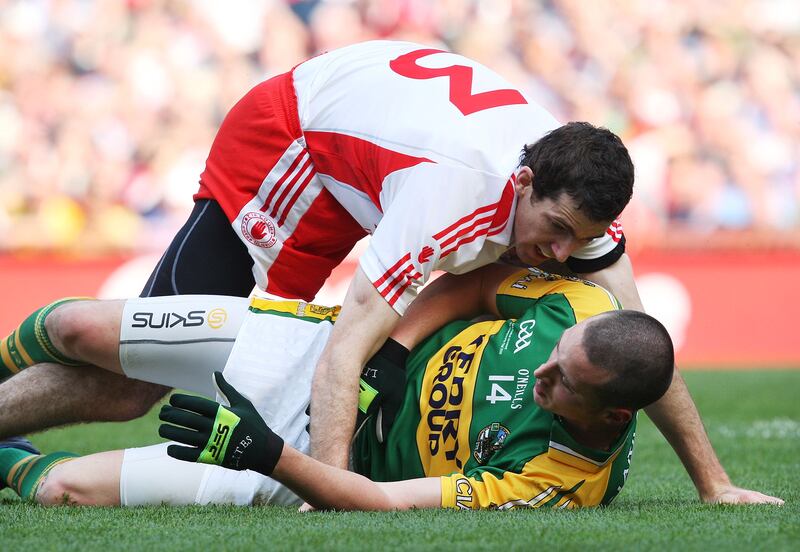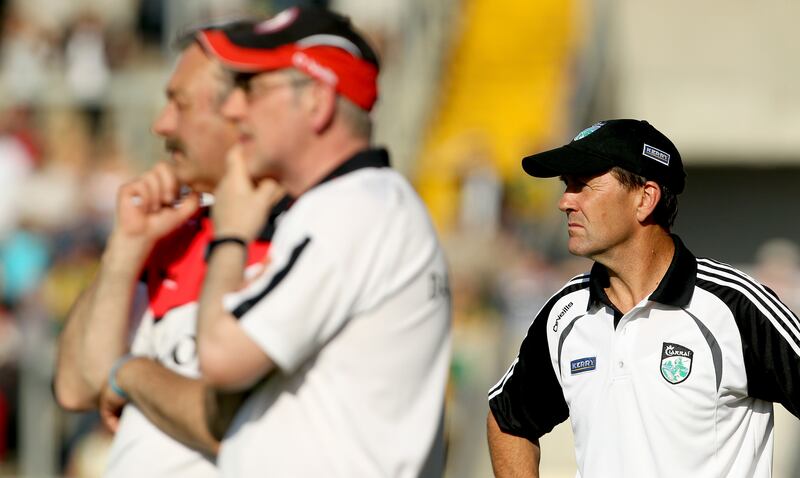Twenty years ago, Kerry were suddenly diagnosed with a Tyrone problem. One day they had no symptoms; the next, they had taken to the bed with a fever. Into the ward walked Jack O’Connor. A young doctor. Not a specialist. Some said unqualified. Kerry was his patient now. Where does it hurt? All over, doctor.
Early in 2004, O’Connor took Kerry to a training camp in Lanzarote. The long shadow of 2003 followed them. In Páidí Ó Sé's last match as Kerry manager, Tyrone beat them by seven points in the All-Ireland semi-final. As a spectacle it was like the chaotic street scenes from A Clockwork Orange.
For Kerry it was a traumatic defeat, but the match had been so grotesque that an element of the Kerry football community took shelter in their outrage. They had lost, but not at a game they recognised. Not at football.
Mickey Harte had set O’Connor a puzzle, and accidentally, he had set him a trap. If Kerry saw themselves as curators of everything that was holy about Gaelic football, is this where they would make their stand? Could they still win by playing the handsome, swashbuckling, romantic lead?
RM Block
O’Connor had not been swept into power with an overwhelming majority and straight away he was faced with an ideological question that, on the face of it, risked alienating large swathes of the electorate. The simple thing would have been to play to the gallery. Stand up for the one true faith. O’Connor’s understanding of his audience, though, was more sophisticated than that. For all the pieties about style espoused by Kerry football people, winning was the deity they worshipped.
“There was a lot of self-pity in Kerry at the end of ‘03,” says former footballer Dara Ó Cinnéide. “We actually didn’t recognise what had happened. Jack did – Jack did, in fairness.
“In early January 2004 he sat us down in a training camp in La Santa out in Lanzarote and he said: ‘Look lads, this is the way football is now. There is no point in us bitching and moaning about it and calling it puke football, as Pat Spillane did. It’s football. You want to beat it? Work harder.’ There was a realisation there, ‘Lads, stop feeling sorry for yourselves.’ It wasn’t in our gift to look down our noses at them.”
O’Connor had the temperate mind to search for sustainable compromises. In a real sense, Harte had forced their hand. Not budging would have been reckless. O’Connor was arbitrating between Kerry’s past and Kerry’s future while they were shouting across the table.
At first, there were elements of imitation. Under the previous management Paul Galvin and Aidan O’Mahony had been fringe players, but in football’s new cryptocurrency their abrasiveness and athleticism had a higher value. Galvin was sitting by the pool at their Lanzarote training camp when O’Connor approached him. Brian Dooher’s name was not mentioned. The resemblance would become clear in time.
“Jack sat beside me and told me I had what he was looking for,” wrote Galvin in his autobiography. “He had a system in mind and needed players to suit.”
“Jack recognised something in Galvin and O’Mahony that was needed to take on the Tyrone model,” says Ó Cinnéide. “It took a bit of work on Jack’s part to mould them. It didn’t happen overnight. It’s an easy narrative to create now, especially when Kerry won the All-Ireland in ‘04. ‘Ah, they’re exactly what we needed.’
“But put yourself in Jack’s shoes 20 years ago and you’re looking at them, saying, ‘Yeah, they have something that I need, but there’s a reason as well why Paidi didn’t pick them.’”
Kerry did not meet Tyrone in the championship until the All-Ireland final at the end of O’Connor’s second season, but the adjustments O’Connor made had a universal application against football’s new designs.
“Carrying the ball too much, and carrying the ball into traffic were things we had to look at,” says Ger O’Keeffe, who was a Kerry selector alongside O’Connor during his first two spells as manager. “To deal with the zonal defence that had come in you needed fellas with the capability to kick the ball 30 or 40 yards accurately, to beat the swarm.”

That was cold tactical stuff, but taking on Tyrone was a multilayered business. There was an incident in the 2005 All-Ireland final that crystallised the psychological warfare. Fifteen minutes before half-time, Colm Cooper was “hit with a flake,” as O’Connor described it in his book.
The Kerry players, though, were under strict instruction not to fight, come what may. Against Tyrone, the possibility of a flashpoint was always live. A row never knocked them out of their stride. Kerry made the calculation that a fight would not be worth their share of the purse.
“The mantra at the time,” says Ó Cinnéide, “was to be aggressive to the point of not fighting. That was a big thing before the game. Aggression, aggression, aggression – but when the whistle is blown, walk away. Match their aggression, but don’t get involved.
“I remember being a bit pissed off afterwards, seeing in my team-mates’ books, that we should have fought when Gooch got the clip over the eye. They said we should have waded in and started a row.
“I’m sure the finger was pointed at me and a few more forwards who were around the scene that we should have [waded in]. Like, we either had an agreement or we didn’t. I stand over that.”
Tomas Ó Sé, in his book, wrote that “your man should have been drilled – put on his backside”. In his book, O’Connor resigned from his original position. “I always told our players that if there was an incident they were to stay out of it. I decided after that [All-Ireland final] never to tell a team to go out on the field and stay out of it.”
Against Harte’s Tyrone in their pomp that was the challenge that heckled all-comers: how do you negotiate the terms of engagement? How do you stake out your own ground? Play nice?
After they lost the 2005 final to Tyrone, O’Connor spent a couple of days in Kenmare, holed up in an empty house owned by his sister-in-law, poring over the tape of the match. Being schooled again.
“The tape of the match is like a work schedule unfolding for me,” he wrote, “setting out everything we’ll need to do for 2006. Toughness will be the mantra for next season. We’ll break tackles and we’ll tackle hard. First, though, I have to go away and actually learn how to coach the tackle. Genuinely, I don’t know how to do that.”
Even though Kerry reached six All-Ireland finals in a row after 2003 – and won four of them – that period in their history is overshadowed by their relationship with Tyrone, and the two finals they lost to them. They had got under each other’s skin.
“Losing to Tyrone is worse than losing to almost anybody else,” wrote O’Connor in Keys to the Kingdom. “There’s an arrogance to Ulster football that rubs people up the wrong way. They’re flash and nouveau riche and full of it.”
In his book, two years later, Harte addressed that quote directly and spent the guts of a page rebutting it. “If Jack wanted to paint a broad brushstroke about northern football,” Harte wrote, “I took it as somebody who didn’t really know what they were talking about.”

In 2008 Tyrone blocked Kerry’s tilt at three-in-a-row in one of the most spectacular finals in living memory. O’Connor had returned to slay the dragon, still scalded from his previous attempt. In the second round of the league in 2009, Tyrone hosted Kerry in Omagh.
Statement league matches between Kerry and Tyrone were a regular occurrence during those years. “Jack took the league games against Tyrone very seriously,” wrote Ó Sé. His second coming was no different. Harte claimed in his book that O’Connor shook his hand before the match without looking him in the eye. At the final whistle, there was no handshake. By then, there was the makings of a melee. In the disciplinary backwash, both counties were fined.
“Jack is out on the field, but he’s not pulling his players away,” wrote Harte. “He’s in Colm McCullagh’s face. Whatever about laying down markers, I won’t be doing it that way. There had been an edgy feel about Kerry all day.”
In the match reports it was widely noted, with arched eyebrows, that Kerry had played with only four full-time forwards. Nobody would dream of such a cavalier formation now, but 15 years ago it was a significant concession for Kerry to make. From O’Connor, it was another sustainable compromise. At that time, Harte always made him think.
They did not meet in the championship that summer, but Harte and O’Connor were still in place the next time the counties met in the qualifiers, three years later. Tyrone were a ghost of the team that had won three All-Irelands, and haunted Kerry. On a blistering summer Saturday, the exorcism was a public spectacle. Kerry won by 10 points.
For James O’Donoghue, it was the first big game of his breakthrough season. It was like nothing he had experienced before. “It was different,” O’Donoghue says. “The energy was different. It was very much, ‘We cannot lose this game.’ There was nothing after, there was nothing before – we do not lose this game. It’s Tyrone. It’s Killarney. We do not lose. It was so emotionally charged. Everyone was just so on edge. When the ball went over the bar for the first score the noise in the stadium was just absolutely insane.”

Tactically, O’Connor dictated everything. Tyrone’s nominal centre forward, Martin Penrose, used to roam deep into his own half and Killian Young was instructed to follow him everywhere. “I remember that was a big statement at the time,” says O’Donoghue, “We’re going to put Killian Young up on him and play seven forwards. We went very aggressive. It was like, ‘We’re not going to sit back and play into their barrow. This is our field. We’re going at this.’”
In Galvin’s book there is a picture of him hugging Harte in the middle of the field after the match. All you can see is the back of Harte’s head enveloped by Galvin’s giant forearm, tattooed from elbow to wrist.
Just a week earlier the men accused of murdering Harte’s daughter Michaela had been acquitted in Mauritius. A couple of hundred Kerry supporters waited around after the match to clap Harte on to the team bus in a show of tenderness and solidarity. Football was something and nothing.
Harte and O’Connor will share a sideline again today, 20 years after the first time. Harte in a different jersey, but wise and inscrutable still. And O’Connor? Harte always made him think.
- Sign up for push alerts and have the best news, analysis and comment delivered directly to your phone
- Find The Irish Times on WhatsApp and stay up to date
- Our In The News podcast is now published daily – Find the latest episode here






















